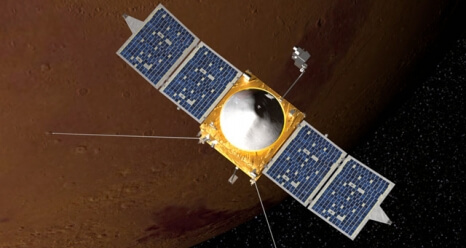
The spacecraft will provide answers about the climatic history of Mars by studying the gases escaping from the atmosphere into space today
On launch pad #41 at the Kennedy Space Center is an Atlas 5 rocket carrying the Maven spacecraft (MAVEN - Mars Atmosphere and Volatile Evolution) which will be launched tomorrow to Mars. At the end of the week the missile was transferred to the launch pad and placed in a vertical configuration.
NASA says that all the work required before the launch has been completed with the exception of charging the battery, but there is enough time for this until the launch is scheduled for Monday at 06:28 EST (13:28 Israel time). There is still a 40% chance that the weather will not meet the favorable launch criteria due to cloud cover.
The Maven spacecraft (acronyms in English: the evolution of the Martian atmosphere and its volatiles) will be the first mission dedicated to a deep understanding of the upper atmosphere of Mars.
The purpose of the MAVEN spacecraft will be to determine the effect of the loss of atmospheric gases into space on the climate of Mars throughout the periods, as well as to understand where the atmosphere and water disappeared. The data that Mayvan will collect will also help scientists estimate how many percent of the Martian atmosphere has been lost over the years by measuring the current rate of gas escapes into space and gathering information about the relevant processes that will allow a retrospective assessment.
On the same topic on the science website:
- December 2013: India also launched a spacecraft to Mars
- NASA announced the Maven Maven mission to study the Martian atmosphere

2 תגובות
First time that a meteorological spacecraft is launched to another body in the solar system other than Earth. Looking a little ahead, it is worth thinking about another possibility.. It may be possible to get full meteorological coverage of Mars using a launcher that operates on the principle of a splitting arrowhead. Launch a cluster of meteorological spacecraft using a single launcher. There will be 6 spacecraft on this launcher. As the launcher approaches Mars, the spacecraft will enter orbit around Mars, 3 spacecraft into a stationary equatorial orbit like communication satellites, which will be 90 degrees apart from each other. The remaining three spacecraft will enter a polar orbit around Mars also at a distance of 90 degrees from each other. Another option is to launch a launcher with 3 spacecraft that will enter orbit around the equator and according to a planned signal will launch these spacecraft one after the other. The second launcher will enter a polar orbit and perform a similar operation. This is an extremely complex and complicated operation that can only be done with international cooperation. Maybe you should start initiating a project of this kind in Israel.
First time that a meteorological spacecraft is launched to another body in the solar system other than Earth. Looking a little ahead, it is worth thinking about another possibility.. It may be possible to get full meteorological coverage of Mars using a launcher that operates on the principle of a splitting arrowhead. Launch a cluster of meteorological spacecraft using a single launcher. There will be 6 spacecraft on this launcher. As the launcher approaches Mars, the spacecraft will enter orbit around Mars, 3 spacecraft into a stationary equatorial orbit like communication satellites, which will be 90 degrees apart from each other. The remaining three spacecraft will enter a polar orbit around Mars also at a distance of 90 degrees from each other. Another option is to launch a launcher with 3 spacecraft that will enter orbit around the equator and according to a planned signal will launch these spacecraft one after the other. The second launcher will enter a polar orbit and perform a similar operation. This is an extremely complex and complicated operation that can only be done with international cooperation. Maybe you should start initiating a project of this kind in Israel.